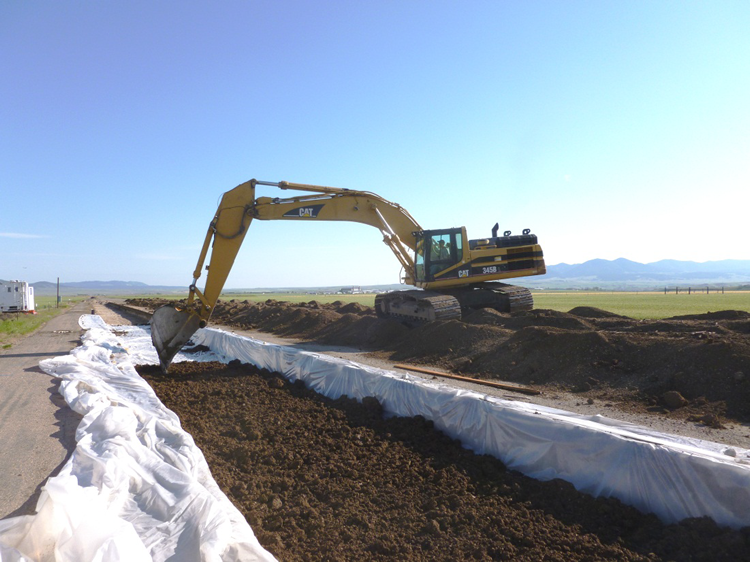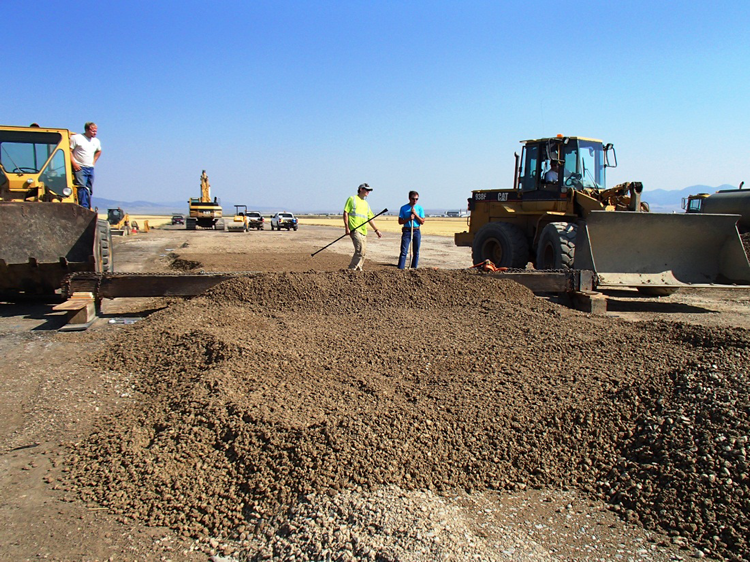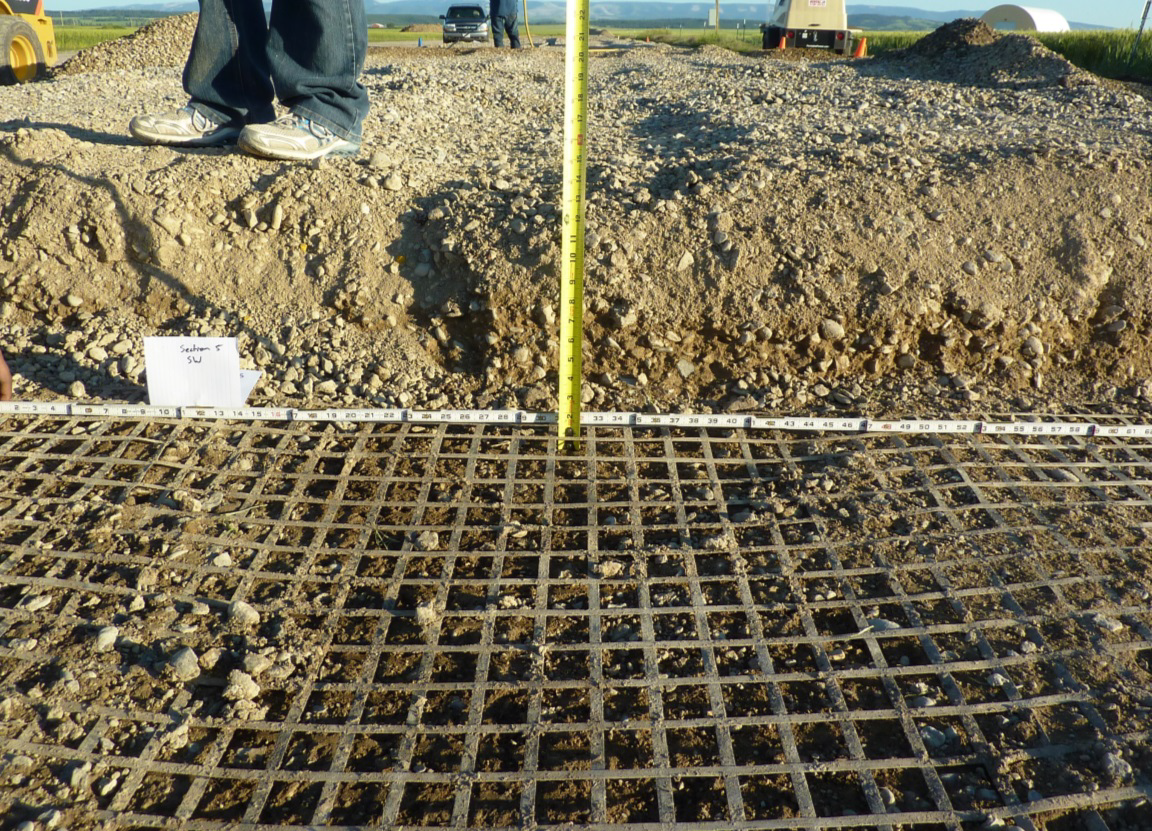From December 2011 through the end of May 2014, the Montana Department of Transportation led a pooled fund study on “Performance of Geosynthetics in Subgrade Stabilization.” The research, which was carried out by the Western Transportation Institute (WTI, based at Montana State University) follows a smaller Phase I, which was carried out in 2008 and 2009 by WTI.
DOWNLOAD A COPY OF THE PHASE II REPORT (PDF)

“In Phase I, the testing conditions were more severe,” says Eli Cuelho, P.E., who led the research and co-authored the report with Steve Perkins and Zachary Morris. “The research in Phase I helped understand what happens under more severe conditions, which do occur in the real world, but in Phase II we wanted to look at performance in more typical, less severe conditions.”
The research picked up where Phase I had left off. This included utilizing WTI’s large outdoor laboratory—the TRANSCEND research facility in Lewistown, Montana. Different subgrade stabilization designs were evaluated.
| LOOKING BACK: PHASE I |
| Phase I Summary Report (PDF) |
| Phase I Final Report (PDF) |
| Phase I Release from Co-Sponsor NAUE |
| Phase I Release from Study Participant Tencate |
“With this second phase we expanded the number of products in the study,” Cuelho says. “We wanted to cover the gamut of the types of geosynthetics that could be used in subgrade stabilization applications—whether it’s a welded, woven or integrally-formed geogrid, or a geotextile.”
Just as in Phase I, a number of manufacturers were represented in the study, including Colbond (Bonar), Huesker, NAUE, Propex, Synteen, SynTec, TenCate and Tensar.
LEARN MORE ABOUT BOTH PHASES AT THE STUDY WEBSITE

Phase I of the research was co-sponsored by NAUE GmbH & Co. KG. The results drew the attention of DOTs and brought about Phase II’s funding mix, which was entirely supported by a geographically broad group of state DOTs: Idaho, Montana, New York, Ohio, Oklahoma, Oregon, South Dakota, Texas and Wyoming.
Geotextiles Move Forward with Geogrids
Geotextiles have been part of the geosynthetics field so long that there are some people who still refer to all geosynthetics generically as geotextiles. At times, this has caused confusion or overshadowed the technical characteristics and performance of geotextiles, including in reinforcement applications. Their common presentation as a “commodity” material has hampered their acceptance in higher strength work.
But the Federal Highway Administration’s (FHWA) use of geotextiles in abutments for its Geosynthetic Reinforced Soil – Integrated Bridge System (GRS-IBS) has helped raised the profile of geotextiles for designers.

Also, a number of companies have stepped up R&D and promotion of geotextiles in reinforcement applications, highlighting not only geotextiles on their own but the performance of geotextile-geogrid composite materials.
WTI’s Phase II Report will certainly continue to keep geotextiles elevated in stabilization discussions.
“Textiles performed very well,” says Cuelho. “The woven geotextile performed very well and even the 8 oz. nonwoven geotextile did very well. I think people will be interested, and maybe a little surprised, at how well these materials performed.”
As expected, most of the geogrids also performed well, and that performance was directly linked to the strength and stiffness of the junctions as well as tensile strength in the cross-machine direction.
The combined results of geotextiles and geogrids highlights the range of choice and performance that geosynthetics provide to soil stabilization applications. They have different price points. They can substantially reduce aggregate thickness. They present traffic benefit ratio (TBR) improvements. Ultimately, they can provide strong options for maximizing economics and performance.
Phase II has verified what most already perceive in geogrids. Geotextiles, however, may have earned a boost. Phase I showed resiliency in geogrids and geotextile-geogrid composites in more severe conditions. In Phase II, under less severe conditions, geotextiles revealed stabilization characteristics that may outperform the perception many engineers have of them.
“Nonwoven geotextiles are primarily used in separation applications,” Cuelho says, “but based on their performance in this study, perhaps secondary structural benefits are also relevant – and that might change some perceptions.”
Currently, geotextiles are not considered for their reinforcement benefit in subgrade stabilization applications; but that may change if additional quantification of the mechanical characteristics of this performance can be better understood.
Phase III on Subgrade Stabilization?
The ink is just drying on the Phase II report, but Mr. Cuelho is already in discussion with some DOTs and private industry on another expansion of the research. More materials, loading conditions, and designs would be welcomed to help further quantify the real mechanisms at work on and within these materials.
Companies and agencies interested in the work and potentially contributing materials or financial resources to support future studies on geosynthetics in a variety of transportation applications should contact Eli Cuelho at elic@coe.montana.edu.
DOWNLOAD A COPY OF THE PHASE II REPORT (PDF)











